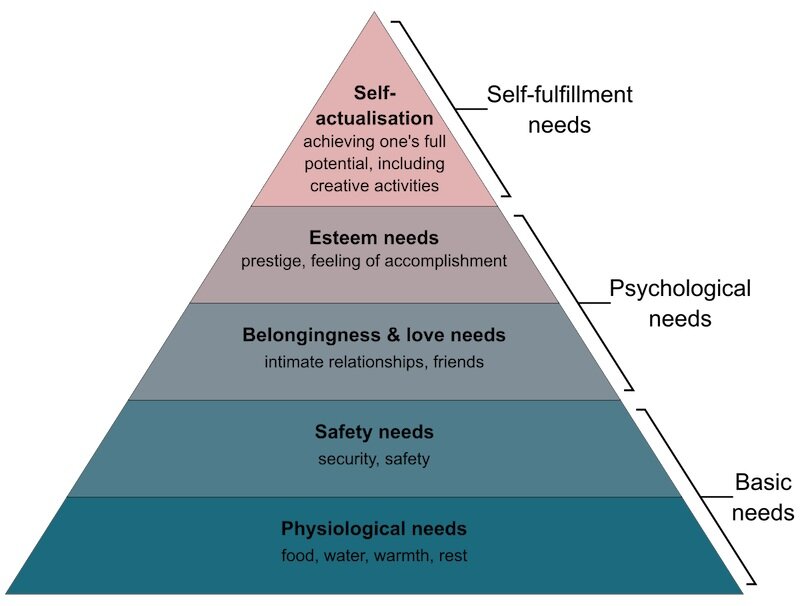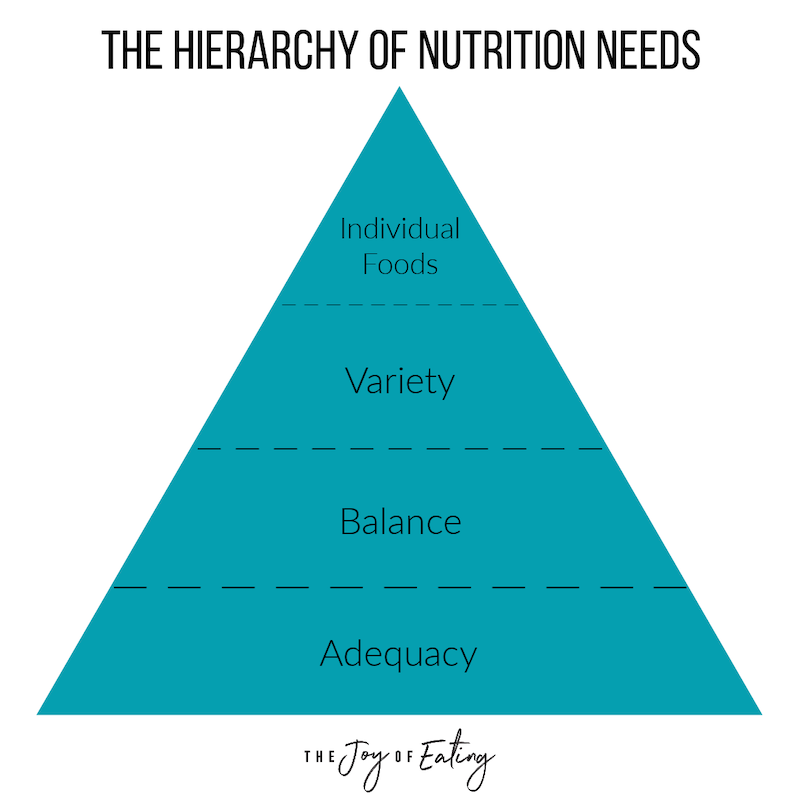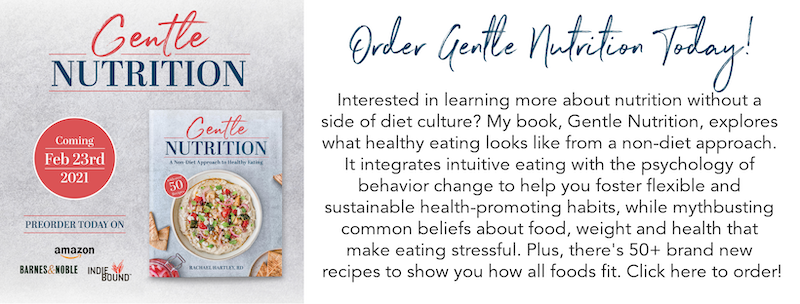The Hierarchy of Nutrition Needs: A Non-Diet Approach to Understanding Nutrition
When it comes to nutrition, don’t miss the forest for the trees. This hierarchy of nutrition needs is a helpful way to reframe nutrition away from the fad of the day, or the little things that don’t matter in the greater context of your eating patterns.
Phew! So after working my rear end off since November on my book, I turned in the edits on my manuscript on Friday! I immediately celebrated with an order of pimento cheese fries and an IPA on the patio of our neighborhood bar, and then by binge watching the entire first season of How to Get Away with Murder from bed. There’s still more work to be done (and lots to catch up on!), but I’m happy to have a smidge more headspace.
As I shared back in January when I announced the exciting book news, the topic of my book is gentle nutrition. There’s SO much out there about nutrition, but so little of it actually helpful, because the vast majority of it is written with the assumption that weight loss or management should be the goal of “healthy eating.” In reality, if the focus of nutrition is all about weight, there’s an inherent conflict, as weight loss is all about cutting things out, while good nutrition is about adding things in.
My hope for the book is reframing nutrition in a way that’s actually helpful for promoting health and positive relationships with food. Which frankly, is really what all nutrition discourse should be centered around.
The Hierarchy of Nutrition Needs
One of the tools I’m sharing in my book is The Hierarchy of Nutrition Needs. This is a model I like to use with my clients to help them conceptualize nutrition in a more helpful way. Most people have heard of Maslow’s Hierarchy of Needs, which essentially shows how people need to fulfill basic needs, like food, shelter, security and rest, before pursuing higher needs, like relationships, self-esteem, and self-actualization.
There’s also dietitian Ellyn Satter’s Hierarchy of Food Needs, which focuses on food access. In it, you can see how we need access to adequate amounts of acceptable foods before engaging with instrumental food (i.e. food for nutrition).
These two models, along with a conversation I had with some dietitian friends inspired my Hierarchy of Nutrition Needs. In that conversation, we vented about how mainstream discourse on nutrition centers around “high level” topics (think “superfoods” and what’s the “healthiest” granola bar) versus the aspects of nutrition that are actually are important. And so, I came up with this hierarchy to communicate a more helpful way to look at nutrition, one that centers on the basics we so often overlook.
Adequacy
Whether or not you are eating enough is by far the most important aspect of nutrition. I don’t care how many blueberries you eat, or how much kale you put in your smoothie, if you’re not fueling your body with enough energy, you are inadequately nourished. The nutrients in those supposed “superfoods” are just going towards your most basic bodily functions - things like your heart pumping, lungs breathing, and your temperature regulating. Calories, macronutrients, vitamins and minerals all play essential roles in the body, a fact we forget in our restriction based diet culture.
Inadequate nutrition adds to allostatic load, the cumulative wear and tear on the body from stress. Higher allostatic load means increased inflammation, and symptoms of allostatic overload might include migraines, insomnia, gastrointestinal problems, chronic pain, inflammation, or high blood pressure.
Another reason adequacy is at the bottom of the pyramid is because not only is it important for health, but you have to be eating adequately to have the headspace to engage with other aspects of nutrition. When you’re hungry, it’s hard to make an intentional choice around food.
It’s important to note that you don’t need to have an eating disorder to not be eating enough. You also don’t have to be in a thin body to not be adequately nourished. In reality, you can be in a fat* body and still not be eating enough. There’s this cultural assumption that if you’re in a larger body, than it must be because you eat too much. For the record, that cultural assumption is BS. Body diversity is a real thing, and if there’s one thing I’ve learned in my 10+ years of practice it’s that you can’t tell a thing about how someone eats by looking at them.
A satisfying takeout meal of falafel, babaganoush, hummus, falaheen salad, caprese, and pita. Generally adequacy rule of thumb: you need at least a plate (or bowl) of food.
*Fat used as a descriptor, not as a pejorative word. There’s a growing movement to reclaim the word fat (read this and this). I occasionally use it to help neutralize the term, however I always try to be sensitive about it’s use as while it should be a neutral descriptor, I know for many people it’s not.
Balance
The balance I speak of here is not trying to undo something “bad” by eating something “good.” The balance I’m talking about is getting all the macronutrients - fat, protein, and carbs - at most of your meals. Each of these macronutrients play a different role in the body, and we function best when we’re eating adequate amounts of all three.
Human beings were designed to be flexible around food. One of the reasons we have evolved to be the dominant species is because we are able to make a meal out of a wide range of food environments, everywhere from the tropics to the arctic. When diets demonize or glorify certain macronutrients, they are ignoring this fact of human adaptability. And to be sure, humans have survived periods of time or environments that have required low/high fat, low/high carb and low/high protein dietary patterns. But in our modern world where we have much greater access to these foods, will you thrive?
A bowl of green tea soba noodles (carbs) tossed with sesame oil (fat) topped with glazed, broiled tofu (protein) and portobello mushrooms (produce) topped with chili-onion crunch condiment (more fat)
Because each macronutrient sends a separate signal to the brain signifying satiety, you’ll feel a lot more comfortable after a meal that contains all three. When levels of glucose (carbs), amino acids (protein) and fatty acids (fat) in the blood rise after a meal, it sends signals to the brain to decrease hunger hormones and increase satiety hormones. That’s why you can eat large quantities of a meal that’s missing a certain macronutrient, and still not feel full, or feel hungry soon after - think a giant salad topped with chicken, or a big bowl of cereal. As with adequacy, it’s much easier to make intentional choices with food when you’re not ravenously hungry.
Variety
Variety is about getting all the different food groups - grains, proteins, dairy, fruits, veggies, nuts & seeds, fats and fun foods. It’s also getting a wide range of foods within those food groups. Different foods contain different nutrients, so by getting a variety of different foods, it ensures you’re getting the nutrients your body needs. Think of variety as a nutritional insurance policy! It also helps improve overall dietary quality, as by aiming to include a variety of foods, it means you’re also bringing in more nutritious foods. And personally, I think variety really ups the pleasure factor!
Lots of variety in my Jamaican takeout lunch (from Island Grill in Cola!) - rice and peas, plantains, jerk chicken with lots of spices (aka flavor nutrients), mac and cheese, and collards for green leafies
Individual Foods
Individual food is an aspect of nutrition you hear about the most, but matters the least in the greater context of nutrition. Mainstream discourse on nutrition loves to glorify specific foods, like the fad food of the moment (hello cauliflower and collagen powders), or pit the healthfulness of foods against each other (like olive oil vs coconut oil vs butter vs whatever!). But this obsession over individual foods is really missing the forest for the trees.
Sure, there are individual foods that can provide specific nutrition benefits, or are particularly packed with nutrition. And, there are times focusing on specific foods can make a difference. For example, oats (and other foods high in soluble fibers) can help lower cholesterol. One of my clients discovered she loved overnight oats, and started eating that most mornings instead of skipping breakfast, and her high cholesterol came down quite significantly (although I know her eating anything for breakfast also had ripple effects too, so can’t put it all on oats!). Another example might be fermented foods, which can be beneficial for gut health for many people.
And yet, this aspect of nutrition doesn’t really matter if you’re not eating enough, getting a balance, and getting a variety. We need these baseline aspects of nutrition for individual foods to matter. Remember, no single food is a magic bullet, no matter how much diet culture may glorify it.
A bagel with omega-3 rich smoked salmon!
Anyway, I hope this is a helpful way for you to contextualize nutrition! Would love to hear your thoughts!
If you found this blog post of my food hierarchy to be helpful, follow my intuitive eating Pinterest board for more support.
If you like this post of the hierarchy of nutrition needs, you might also like:
How to Practice Gentle Nutrition in Intuitive Eating












